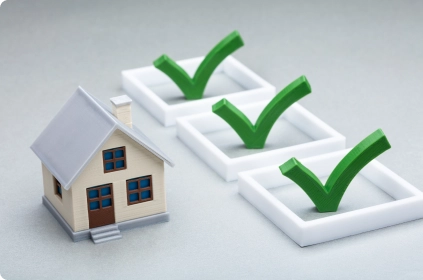The amount of money you can borrow depends on how much you have available to ‘service’ future loan repayments. Lenders assess your income, debts, and spending habits to determine your borrowing power. One factor in this assessment is your living expenses, the day-to-day costs of running your household, such as groceries, utilities, transport, and personal spending.
Knowing your living expenses while applying for a home loan is essential. It helps you prove that you are financially responsible and capable of making future repayments. Accurately reporting your expenses also ensures you don’t overcommit to a loan that might stretch your budget too thin.
Use our living expense calculator to calculate your expenses based on your living arrangement, lifestyle, and number of dependants.
Why do banks care about my living expenses?
When banks assess your ability to borrow, one of the major factors they evaluate is your spending compared to income.
Your living expenses are a good indication of your character as a potential borrower.
Specifically, banks will first identify your necessary regular spendings such as your bills and groceries.
They then compare that to your regular discretionary spending on items or activities that are not necessary on a day-to-day basis.
For example, banks will raise red flags for regular spending at pubs and clubs or spending on luxury fashion items.
In this way, they’re able to calculate your serviceability or borrowing power.
The key to maximising your mortgage borrowing power is finding a lender that takes a common-sense approach to your spending.
These lenders recognise areas where you can easily and quickly reduce your discretionary spending, such as in entertainment and dining out.
Call us on 1300 889 743 or complete our online enquiry form and we can help you build a strong home loan application.
How do banks calculate your living expenses?
Lenders use a few different methods, including:
- Using the Household Expenditure Method (HEM) based on your family size and income (Australian Bureau of Statistics data) because it is considered unreasonable for someone to spend less than HEM each month.
- Asking you to self-assess your living expenses on your home loan application form.
- Reviewing any bank account (cheque or savings accounts) or credit card statements they have access to confirm your self-assessment.
- Either accepting or adjusting your stated expenses to match your bank account history.
- Either using the higher of the above living expense assessment methods to calculate your living expenses.
How will the living expenses calculator help me?
Borrowers are required to manually work out their living expenses on a weekly or monthly basis when they complete their home loan application.
You’ll still need to self-assess, but the calculator will give you a reasonably accurate indication of how your spending compares to the average monthly cost of living in Australia.
Are you spending more than the HEM?
The calculator result should act as a general guide only, as your living expenses can vary significantly depending on how you choose to spend your money.
It’s best to speak with a mortgage broker to discover whether there are lending options available to you.
In some cases, it may be a matter of setting a 3-6 month plan of budgeting and cutting out necessary spending.
Check out our prepare to buy program if you’re not quite ready for a home loan.
Tips for using the calculator
The calculator takes all basic living expenses into account such as groceries, utilities, phone, public transport/car and entertainment.
The cost of renting or mortgage repayments is calculated separately so you can replace the figure with your own estimate after you decide where you’d like to live.

Make Informed Decisions With The 360° Home Loan Assessor
- Determine how much you can contribute as a deposit
- Get clarity on the total costs of buying a home
- Explore interest-rate options based on your situation
The most expensive cities in Australia
The most expensive cities in Australia are Sydney and Melbourne, followed by Perth and Canberra.
However, it’s people living in the other capital cities such as Brisbane and Adelaide that have some of the lowest living expenses in Australia.
An exception to this is if you live in a very remote area such as a mining town. You may find that your average cost of living is high due to the cost of bringing goods and services to your community.
What items are expensive in Australia?
The cost of living in Australia is significantly higher than most countries, including other developed nations like the UK and the US.
In particular, you’ll find that the following items are much more expensive:
- Housing (rent and house prices)
- Alcohol
- Tobacco
- Petrol
However, Australians tend to have a much higher income, so it’s still possible to enjoy a good lifestyle.
Why do banks use the HEM?
Under the National Consumer Credit Protection Act 2009, Australian banks must make allowances for living costs when they run borrowing power or serviceability assessments for applicants.
Industry regulator, the Australian Prudential Regulation Authority (APRA), doesn’t provide specific dollar figures for banks to adhere to, so for years they were using the Henderson Poverty Index or Henderson Poverty Line and added an allowance.
In 2012, the Commonwealth Bank (CBA) switched to HEM, and other banks followed.
What is the Household Expenditure Measure (HEM)?
The HEM (Household Expenditure Measure) was developed by the Melbourne Institute of Applied Economics in 2011 as a measure that reflects a modest level of weekly household expenditure for various types of families.
Banks use this benchmark to estimate a borrower’s annual living expenses.
Roughly, 70%-80% of lenders (estimated) have adopted HEM as a benchmark.
What are the types of expenses in HEM?
The three types of living expenses in HEM are:
- Basic
- Discretionary
- Non-basic
HEM benchmark only includes basic and discretionary expenses.
How is HEM calculated?
HEM uses a median expenditure on ‘Basic’ expenses such as food purchased from a supermarket and children’s clothing, combined with 25% of spending on ‘Discretionary’.
The HEM benchmark is income-adjusted, meaning it recognises that higher-income consumers generally have higher living expenses and vice versa.
What expenses are not included in HEM?
Non-Basic expenditures not included in the HEM benchmark are:
- Rent
- Mortgage repayments and other home loan purchase costs
- Non-Government school primary and secondary fees
- HECS/HELP
- Lease payments (other than vehicle leases)
- Alimony and maintenance payments
- Medical charges
- Superannuation, annuities and life insurance
- Counselling services
- Sickness and personal accident insurance
- Legal, accounting and tax agent fees
- Union and professional association fees
- Gambling
However, lenders will still consider some of these expenditures to be discretionary living expenses if they are considered ongoing.
The HEM benchmarks can be a useful tool to help determine whether the information provided is more or less likely to be true.
For example, if a borrower’s declared expenses are well above HEM figures, the lender is likely to believe that the information provided is accurate.
Conversely, if those declared expenses are below benchmark figures, the lender is likely to have reasons to believe that the information is not correct.
What are the new changes to HEM?
Following the release of the Household Expenditure Measure (HEM) 2019 Q2 by the Melbourne Institute, most lenders have updated their benchmark living expenses and made a few changes:
- Lenders now use the total gross (before tax) application income from all sources including gross rental income.
- Investment property expenses are now offset against rental income. The gross shaded rental income less investment property cost is added to the taxable gross income to determine the marginal tax rate and calculate net income.
- The definition of a dependent has changed from ‘a child under the age of 18’ to include ‘a child 18 years or over who lives with the applicant(s) and is totally financially reliant on the applicant(s)‘.
Example of HEM living expenses measure
The cost of living can vary significantly depending on the makeup of your household.
Below are some example results of the living expenses calculator, which include the cost of monthly mortgage repayments based on average Australian house prices:
- Living cost in Australia for one person: $2,835 per month
- Average living expenses for a couple: $4,118 per month
- Average monthly living expenses for a family of 4: $5,378
Input your details into our living expenses calculator to find out how your living expenses compare with the national average.
Banks don't just rely on the HEM
Most Australian banks indeed rely on the HEM as a guide, but they also use their own measures, such as adding an assessment rate or interest rate buffer.
By assessing your borrowing capacity at a higher rate, they can determine whether you’ll still be in a comfortable financial position should interest rates rise.
Banks don’t publish these rates and HEM buffers.
Relying heavily on living expenses is not a perfect system
When lenders ask you to estimate your living expenses, they take the higher of the HEM or your declared costs.
The problem with having a high income is that they’ll tend to scale up your living expenses to be appropriate for your income, thus reducing your borrowing power.
Similarly, if your declared living expenses are too low, you may get knocked back even though, in reality, you may be great with your spending.
Want to know if you qualify for a home loan?
We’re specialists in the lending policies of the major banks and many second-tier lenders.
Some of our lenders take a more common-sense approach to your spending, allowing you to maximise your borrowing power and get approved for the loan amount you need.
Call us on 1300 889 743 or complete our free assessment form to speak with one of our mortgage brokers today.
